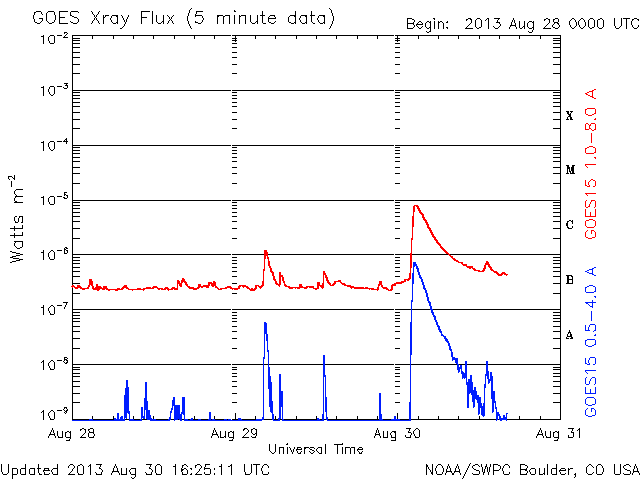Space Weather Alert - 30th August 2013
What Has Happened?
A full-halo coronal mass ejection (CME) was observed leaving the Sun at approximately 02.48 UT on 30 August. This was associated with a long duration C-class solar flare which originated in the Eastern half of the solar disc. While the bulk of the ejecta is not earthbound, a glancing blow is expected to reach the Earth's magnetic field during 1st September.
The combined effect of this CME and the high speed solar wind stream from a coronal hole could cause a geomagnetic storm, thus increasing the chance of viewing the aurora over the weekend.
Assuming clear dark skies, there is an increased chance of seeing the aurora in the hours following the arrival of the CME, particularly at high latitudes in the North of Scotland. Depending on the strength of the storm, there is some chance that aurorae might be visible further south.
Sign-up to receive Geomagnetic Disturbance Alert emails.
Follow us on Twitter:
Follow @BGSauroraAlert for more occasional aurora alerts.
Follow @BGSspaceWeather for daily space weather forecasts.
Glossary
- BGS
- The British Geological Survey is one of the Natural Environment Research Council's Research Centres.
CME or Coronal Mass Ejection- The eruption of a portion of the outer atmosphere of the Sun into space, caused by rapid changes in its magnetic field. Often occurs along with a solar flare.
- Coronal Hole
- A region in the Sun’s outer atmosphere (corona) where hot material can flow unrestrained by its magnetic fields out into space.
- Filament Eruption
- An eruption of solar plasma (i.e. ions and electrons) associated with the upward movement of solar magnetic field lines into the corona. Filaments are usually dark against the bright solar disk but can appear bright (as 'erupting prominences') on the limbs of the Sun against the darkness of space. Filaments are often associated with CMEs.
- Flare
- Energy released by the explosive reorganisation of magnetic fields within the Sun's atmosphere.
- High Speed Stream
- A fast moving stream of solar wind, responsible for magnetic storms.
- Magnetogram
- The variation, minute by minute, of the strength and direction of the Earth’s magnetic field. Measured in units of nano-Tesla (for the strength of the field) or in degrees (direction of the field).
Solar Wind- The ever-present expansion of the Sun’s hot outer atmosphere into the solar system, which carries space weather within it.
Sunspot- A region of intense magnetic field in the Sun's visible outer atmosphere often associated with flares and CMEs.



